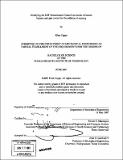| dc.contributor.advisor | Steven G. Massaquoi. | en_US |
| dc.contributor.author | Cappo, Ellen (Ellen Angeline) | en_US |
| dc.contributor.other | Massachusetts Institute of Technology. Dept. of Mechanical Engineering. | en_US |
| dc.date.accessioned | 2008-02-27T22:23:07Z | |
| dc.date.available | 2008-02-27T22:23:07Z | |
| dc.date.copyright | 2007 | en_US |
| dc.date.issued | 2007 | en_US |
| dc.identifier.uri | http://hdl.handle.net/1721.1/40418 | |
| dc.description | Thesis (S.B.)--Massachusetts Institute of Technology, Dept. of Mechanical Engineering, 2007. | en_US |
| dc.description | Includes bibliographical references (leaf 16). | en_US |
| dc.description.abstract | This research continues the work begun by Sungho Jo and Steve G. Massaquoi on modeling human walking and upright balance. The model of human neurological control of balance and gait generation put forward by Jo and Massaquoi in "A model ofcerebrocerebello-spoinomuscular interaction in the sagittal control of human walking" and executed in MATLAB Simulink/SimMechanics. This model has been used to determine the feed-forward command sequences for the generation of walking and running gaits. Furthermore, two feedback circuits controlling the center of mass relative to the swing leg and the composted leg angle of the simulated model were added. These provide a basis for a wider control of disturbances in order to implement running. This work helps forward the long-term goals of the MIT Sensorimotor Control Group--creating a control model of the neurological circuitry responsible for governing human balance and locomotion and testing that model by using it to control a bipedal robot. The results of this research help to prove the validity of the cerebrocerebello-spinomuscular control model developed by Jo and Massaquoi and point positively towards the introduction of the running of the control model on a physical robot. | en_US |
| dc.description.statementofresponsibility | by Ellen Cappo. | en_US |
| dc.format.extent | 16 leaves | en_US |
| dc.language.iso | eng | en_US |
| dc.publisher | Massachusetts Institute of Technology | en_US |
| dc.rights | M.I.T. theses are protected by copyright. They may be viewed from this source for any purpose, but reproduction or distribution in any format is prohibited without written permission. See provided URL for inquiries about permission. | en_US |
| dc.rights.uri | http://dspace.mit.edu/handle/1721.1/7582 | |
| dc.subject | Mechanical Engineering. | en_US |
| dc.title | Modifying the MIT Sensorimotor Control Lab model of human balance and gait control for the addition of running | en_US |
| dc.title.alternative | Modifying the Massachusetts Institute of Technology Sensorimotor Control Lab model of human balance and gait control for the addition of running | en_US |
| dc.type | Thesis | en_US |
| dc.description.degree | S.B. | en_US |
| dc.contributor.department | Massachusetts Institute of Technology. Department of Mechanical Engineering | |
| dc.identifier.oclc | 191699156 | en_US |
